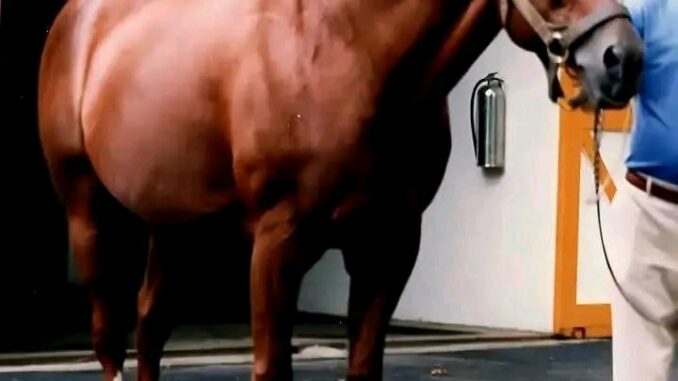
“He Didn’t Just Win. He Changed What Winning Meant.”
The Story of Secretariat ❤️
In the spring of 1973, the world witnessed something that seemed almost supernatural—a chestnut thoroughbred with a white blaze down his face who didn’t just run; he flew. His name was Secretariat, and his story transcends sports. He wasn’t simply a racehorse; he was a phenomenon, a living embodiment of perfection, power, and poetry in motion. Fifty years later, his name still echoes through time, not because he won—but because he redefined what winning truly meant.
Born on March 30, 1970, at the Meadow Stud in Virginia, Secretariat was bred from racing royalty. His sire was Bold Ruler, a champion known for speed, and his dam, Somethingroyal, brought stamina and grace. Yet, no one—not even his owner, Penny Chenery—could have imagined the destiny that awaited this foal. At first, he looked ordinary, perhaps even unremarkable. But within a year, handlers noticed something strange: a presence, a calm intelligence, and a gait that made trainers stop and stare.
By the time Secretariat began racing, he wasn’t just fast—he was dominant. His 1972 two-year-old season was one of the best in history, earning him the title of Horse of the Year, an honor almost never given to a horse that young. But the real magic began the following year, when he entered the most grueling challenge in American horse racing: the Triple Crown—the Kentucky Derby, Preakness Stakes, and Belmont Stakes.
What Secretariat did in those five weeks of 1973 is the stuff of legend. In the Kentucky Derby, he did something no horse had ever done before or since—he ran each successive quarter-mile faster than the last. Horses are supposed to slow down as the race progresses; Secretariat only accelerated. He finished with a record time of 1:59 2/5, still untouched after more than five decades.
Two weeks later, at the Preakness Stakes, he broke from the gate awkwardly but quickly surged ahead, displaying an otherworldly burst of speed that defied physics. Cameras struggled to keep up. His time—though disputed for years—was eventually confirmed as another record, setting the stage for immortality.
Then came June 9, 1973, the Belmont Stakes—the day Secretariat became eternal. The track was buzzing with 70,000 spectators, the air thick with anticipation. His jockey, Ron Turcotte, later said that Secretariat was so confident that day, he almost seemed to know what was about to happen. When the gates opened, the chestnut thunderbolt leapt forward and never looked back.
Halfway through the race, the crowd stood in disbelief. Secretariat wasn’t just winning—he was demolishing the field. The announcer, unable to contain his awe, cried out:
“He is moving like a tremendous machine!”
Secretariat crossed the finish line 31 lengths ahead of the nearest horse—a margin so vast it looked unreal. His time of 2:24 flat set a record for the 1½-mile distance that still stands today, over 50 years later. No horse has ever come close. His average speed during that race? A mind-bending 37.5 miles per hour—sustained for a mile and a half.
But Secretariat’s story is about more than just numbers. When veterinarians examined him after his death in 1989, they discovered that his heart was nearly twice the size of an average thoroughbred’s—estimated at 22 pounds. It wasn’t a disease; it was simply extraordinary. That massive heart powered not only his body but an era—a symbol of what greatness looks like when it meets destiny.
His owner, Penny Chenery, who fought to keep her family’s farm afloat during a male-dominated era, once said,
“He was not ours. He belonged to everyone who believed in the impossible.”
And indeed, Secretariat’s triumph came at a time when America needed hope. The early ’70s were a turbulent era—marked by the Vietnam War, Watergate, and social unrest. Yet, for those few minutes on the track, the world stopped. People cheered, cried, and felt something pure again. Secretariat didn’t just win; he reminded humanity what beauty and excellence looked like.
He retired that same year, going on to sire future champions, but no offspring ever truly replicated his majesty. Some things are simply unrepeatable. When he died at 19, he was buried whole—a rare honor in racing—because to many, he wasn’t just a horse; he was a legend in full.
Today, statues of Secretariat stand in racetracks and towns across America. His legacy lives on in films, books, and documentaries—but most of all, in the hearts of those who watched him run. Because when Secretariat raced, he didn’t just cross the finish line first.
He crossed into immortality.
❤️ Secretariat didn’t just win races—he redefined greatness itself.
Leave a Reply